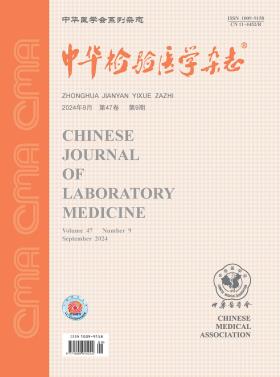化脓性脑膜炎患儿脑脊液肝素结合蛋白测定的临床价值
Q4 Health Professions
引用次数: 0
摘要
目的探讨脑脊液(CSF)肝素结合蛋白(HBP)检测在儿童化脓性脑膜炎(PM)诊断及预后预测中的临床价值。方法对2018年8月至2019年1月湖南省儿童医院收治的76例PM患儿、55例病毒性脑炎患儿和40例非传染性疾病患儿进行回顾性研究。出院时根据格拉斯哥预后量表将PM患儿分为预后良好组和预后不良组。分析PM组、VE组和对照组患者入院第1天(DAY1)及PM组患者入院第7天(DAY7)脑csf HBP、白细胞计数(WBC)、中性粒细胞百分比(N%)、葡萄糖(Glu)、总蛋白(TP)、乳酸脱氢酶(LDH)、血清降钙素原(PCT)。采用非参数检验检测实验室指标的差异,采用Spearman秩相关检验分析HBP与其他指标的相关性。建立受试者工作特征曲线(ROC曲线),评价检测指标对PM的诊断和预后的价值。结果脑脊液HBP的差异[63.09 ng / mL (18.10 - -272.19), 5.90 ng / mL(5.90 - -6.40)和5.90 (5.90 - -5.90)ng / mL),白细胞(365.00(20.00 - -1285.00)×106 / L, 21.00(8.00 - -30.00)×106 / L和13.50(7.25 - -21.00)×106 / L), N %[0.65(0.50 - -0.79), 0.19(0.10 - -0.25)和0.21 (0.15 - -0.27)],Glu[1.97更易/ L(1.07 - -3.08), 2.89(2.66 - -3.42)更易/ L和3.04(2.68 - -3.42)更易/ L), TP [1.43 (0.63 - -1.88) g / L, 0.23 (0.16 - -0.32) g / L和0.13 (0.10 - -0.31)g / L), LDH [152.00 (46.50 - -461.50) IU / L,PM组、VE组和对照组血清PCT水平分别为16.00(13.20 ~ 22.00)IU/L、16.00(10.25 ~ 19.75)IU/L和1.35(0.19 ~ 9.33)ng/mL、0.06(0.03 ~ 0.11)ng/mL和0.08(0.05 ~ 0.14)ng/mL,差异均有统计学意义(HHBP=138.62、HWBC=69.72、HN%=106.67、HGlu=34.08、HTP=68.00、HLDH=85.11、HPCT=79.20, P < 0.05)。在最佳临界值(128.84 ng/mL)下,HBP预测不良预后的AUC(0.976)最大,敏感性、特异性、阳性预测值、阴性预测值分别为100.0%、93.8%、76.3%、100.0%,且均为最佳临界值(P<0.05)。脑脊液HBP与CSF WBC、N%、TP、LDH、血清PCT水平呈正相关(rWBC=0.670, rN%=0.802, rTP=0.562, rLDH=0.524, rPCT=0.436, P<0.001),与CSF Glu水平呈负相关(r=-0.469, P<0.001)。结论脑脊液HBP在儿童化脓性脑膜炎的诊断和预后预测中具有重要价值。关键词:肝素结合蛋白;抗菌阳离子肽;化脓性脑膜炎;脑脊液;孩子本文章由计算机程序翻译,如有差异,请以英文原文为准。
Clinical value of determining heparin-binding protein of cerebrospinal fluid in children with purulent meningitis
Objective
To explore the clinical value of determining heparin-binding protein(HBP) of cerebrospinal fluid(CSF) in the diagnosis and prognostic prediction in children with purulent meningitis(PM).
Methods
76 children with PM, 55 children with viral encephalitis(VE) and 40 control children with non-infectious diseases, all admitted to Hunan Children′ Hospital from August 2018 to January 2019, were enrolled in this retrospective study. Children with PM were divided into favorable prognosis group and poor prognosis group according to the Glasgow Outcome Scale on discharge. CSF HBP, white blood cell count(WBC), percentage of neutrophilic granulocyte(N%), glucose(Glu), total protein(TP), lactic dehydrogenase (LDH) and serum procalcitonin(PCT) were analyzed on the first day of admission(DAY1) in PM group, VE group and control group, and on the seventh day of admission(DAY7) in PM group. Nonparametric tests were used to detect the differences of the laboratory indexes and Spearman rank correlation test was utilized to analyze the correlation between HBP and other markers. Receiver operating characteristic curves (ROC curves) were established to evaluate the values of the detection indexes in the diagnosis and prognosis of PM.
Results
The differences of CSF HBP[63.09(18.10-272.19)ng/mL, 5.90(5.90-6.40)ng/mL and 5.90(5.90-5.90)ng/mL], WBC[365.00(20.00-1285.00)×106/L, 21.00(8.00-30.00)×106/L and 13.50(7.25-21.00)×106/L], N%[0.65(0.50-0.79), 0.19(0.10-0.25) and 0.21(0.15-0.27)], Glu[1.97(1.07-3.08)mmol/L, 2.89(2.66-3.42)mmol/L and 3.04(2.68-3.42)mmol/L], TP[1.43(0.63-1.88)g/L, 0.23(0.16-0.32)g/L and 0.13(0.10-0.31)g/L], LDH[152.00(46.50-461.50)IU/L, 16.00(13.20-22.00)IU/L and 16.00(10.25-19.75) IU/L] and serum PCT[1.35(0.19-9.33)ng/mL, 0.06(0.03-0.11)ng/mL and 0.08(0.05-0.14)ng/mL] levels on DAY1 were statistically significant among PM group, VE group and control group(HHBP=138.62, HWBC=69.72, HN%=106.67, HGlu=34.08, HTP=68.00, HLDH=85.11, HPCT=79.20, P 0.05). But the indexes on DAY7 for predicting poor prognosis were significant (P<0.05) and HBP still had the largest AUC (0.976) for predicting the poor prognosis with good sensitivity, specificity, positive predictive value, negative predictive value (100.0%, 93.8%, 76.3%, 100.0%, respectively) at the optimal cut-off value(128.84 ng/mL). CSF HBP was positively correlated to CSF WBC, N%, TP, LDH, serum PCT level(rWBC=0.670, rN%=0.802, rTP=0.562, rLDH=0.524, rPCT=0.436, P<0.001) and negatively correlated to CSF Glu level(r=-0.469, P<0.001).
Conclusions
CSF HBP is valuable in the diagnosis and prognostic prediction in children with purulent meningitis.
Key words:
Heparin-binding protein; Antimicrobial cationic peptides; Purulent meningitis; Cerebrospinal fluid; Child
求助全文
通过发布文献求助,成功后即可免费获取论文全文。
去求助
来源期刊

中华检验医学杂志
Health Professions-Medical Laboratory Technology
CiteScore
0.40
自引率
0.00%
发文量
8037
期刊介绍:
 求助内容:
求助内容: 应助结果提醒方式:
应助结果提醒方式:


